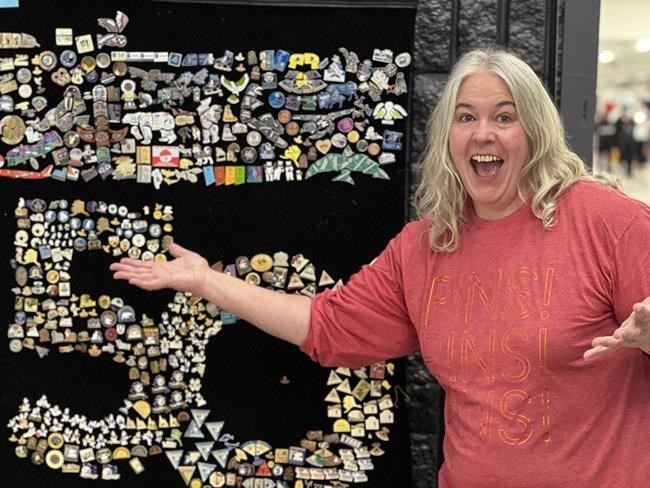FORT MCMURRAY, Alta. — Beyond the wrestling mats, ice rinks and slopes at the Arctic Winter Games, there's another beloved unofficial sport underway.Â
New and seasoned pin traders, affectionately known as "pinheads," can often be found at the biennial sporting event swapping pins from across the circumpolar north or on the hunt for rare ones to add to their trove.Â
Janet Pacey from Yellowknife has been trading pins for years, amassing an impressive collection which she said likely includes upwards of 40,000 pins.
"I always say it's the raven effect. Everything's quite shiny," she said.Â
"It's the thrill of the chase of trying to find that one elusive pin to make up your set."
It's also a great way to meet new people and make friends, she added.
At each Arctic Winter Games, the host society and competing teams release new sets of decorative pins, with some coming together like a puzzle to form an image.Â
Pacey said some of her favourites in her collection include a set from Nunavut that form an igloo, and a set she designed for CBC that create a snowflake.Â
Unlike some who collect pins from several sporting events such as the Olympics or Canada Games, Pacey said she's only interested in the Arctic Winter Games.Â
"I think it's the fact that it's northern kids. It's a very special event, it's very inclusive and it's very cultural," she said. "It's a blast and it's funny because I've seen some kids grow up."
Pacey said she began collecting pins in 2000 when she designed her first set for CBC for that year's games in Whitehorse. But it wasn't until she attended the 2004 Games in Wood Buffalo, Alta., in person that her passion for trading them began.Â
At this year's Games, also held in Wood Buffalo, a municipality in northeastern Alberta that includes the city of Fort McMurray, Pacey has been busy running the pin trading centre, where people can learn all about the practice and check out the latest pins.Â
"Display what you want to trade and hide what you want to keep," is her advice to new pin traders.Â
Pacey said she shipped more than 130 kilograms of pins to the Games and has given most of them away to kids in "starter packs" to help them begin trading.Â
"I keep running out," she said. "The demand has been insane."
The Arctic Winter Games, which began in Yellowknife in 1970, are a circumpolar sport competition held every two years.Â
This year, athletes from the N.W.T., Yukon, Nunavut, northern Quebec and Alberta, Alaska, Greenland, and Indigenous people, or Sami, from Norway, Sweden and Finland are competing in 20 sports from archery and hockey to Dene Games. The Games end Saturday.Â
This report by The Canadian Press was first published Feb. 4, 2023.
— By Emily Blake in Yellowknife
This story was produced with the financial assistance of the Meta and Canadian Press News Fellowship.
The Canadian Press




